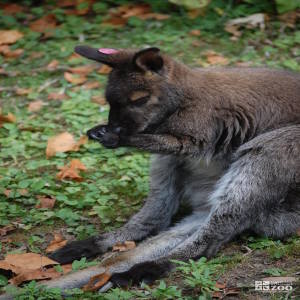Bennett's Wallaby
[Macropus rufogriseus]

The Bennett's wallaby is one of the largest of the 17 species of wallabies. It has a pronounced reddish tone to the fur on its shoulders and rump. They have large muscular hind legs with very long phalanges that enable the hopping motion they use to get around. By contrast their fore legs are small and are just held loosely while the animal is moving. They are about 2.5 to 3 ft. long with a 3-ft. tail and weigh 20 to 30 lbs. These animals live in smaller groups than kangaroos. They prefer to eat grasses in fairly open areas where they can see predators coming and have room to escape. Like the kangaroo, the wallaby pants in hot weather and cools itself by licking the arms and chest.
Location: Wallaby Walkabout
Share:
Range
The range of Bennett's wallaby is Southern Australia and Tasmania.
Habitat
Bennett's wallaby inhabits grasslands, brush and scrubland.
Conservation Status
Least ConcernPrimary Threats
Gestation
Gestation in Bennett's wallaby occurs in about 40 days.
Litter
1
Behavior
Bennett's wallabies live in smaller groups than kangaroos. They prefer to eat grasses in fairly open areas where they can see predators coming and have room to escape. However they also enter forested areas for young tender leaves that supplement their diet of grass
Reproduction
The young Bennett's wallaby (usually one) is born in a very immature state after a very short gestation. The baby then crawls into the mother's pouch where it may stay another 5-11 months. The rate of growth is determined by how well the mother eats, and therefore how much milk she makes. Male and female babies grow at about the same rate until they leave the pouch at which time the males begins growing at a much faster rate so that adult males end up rather larger then adult females.
Wild Diet
Grass and leaves
Zoo Diet
Grain, apples, bananas, sweet potatoes, carrots, guinea pig pellets, vitamin supplements
